In this post, you will learn how to find shared matches on Ancestry DNA, what a shared match is, what it means when you share a match with someone, and how to use the information to get the most from your DNA results.
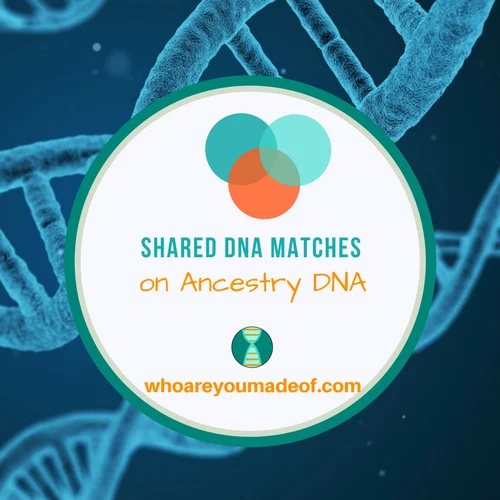
The "Shared Matches" feature is one of the most helpful features available to you from your DNA match profile page. Using shared matches, you can figure out how other DNA matches might be related to you, learn more about your family tree, and even break through brick walls - tough spots on your family tree.
Tip: Shared matches are especially helpful if you have a "mystery match", especially a closely related mystery match, they have no family tree, and have not responded to your messages.
How to access Shared Matches feature on Ancestry DNA
It's easy to access the Shared Match feature on Ancestry, and many of you might have already noticed it. For those who haven't used it before, this is a brief description of where it is located on your Ancestry DNA results.
Once you are logged in to you DNA results, look down to where you see something that looks like this (the exact numbers will be different for every Ancestry DNA user). Click where it says "View All DNA Matches".
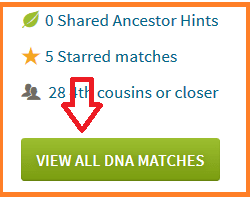
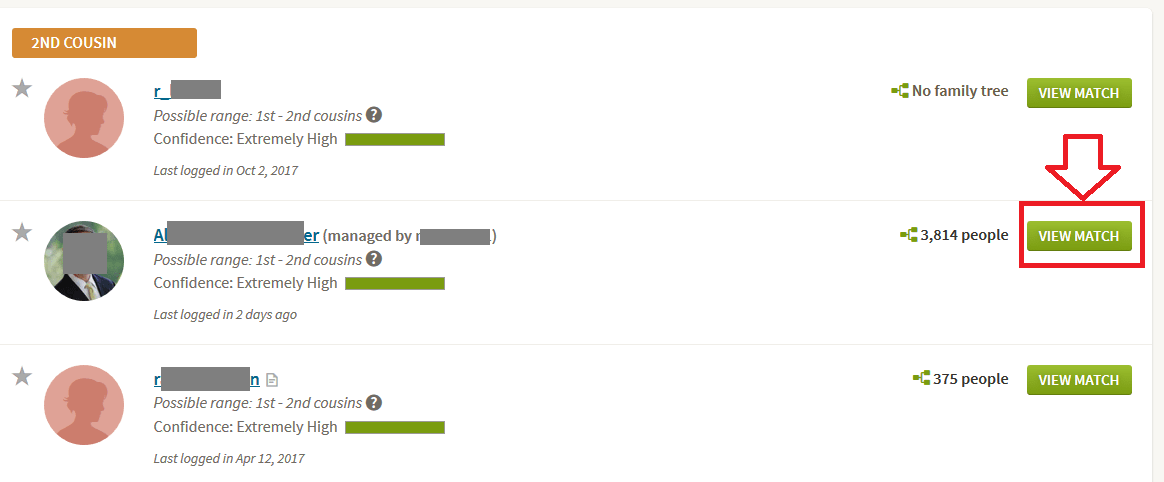
You should now see a list of your DNA matches that looks something like the image below. Click on "View Match" to access the DNA match profile page, which is where you will find much more information about your match than is shown on the list:
Once you've clicked on the "View Match" button from you DNA match list, you will then see the DNA match profile page. This is where you will see how much DNA you share, your matches ethnicities, the predicted relationship, their family tree (if they have one), and your Shared Matches.
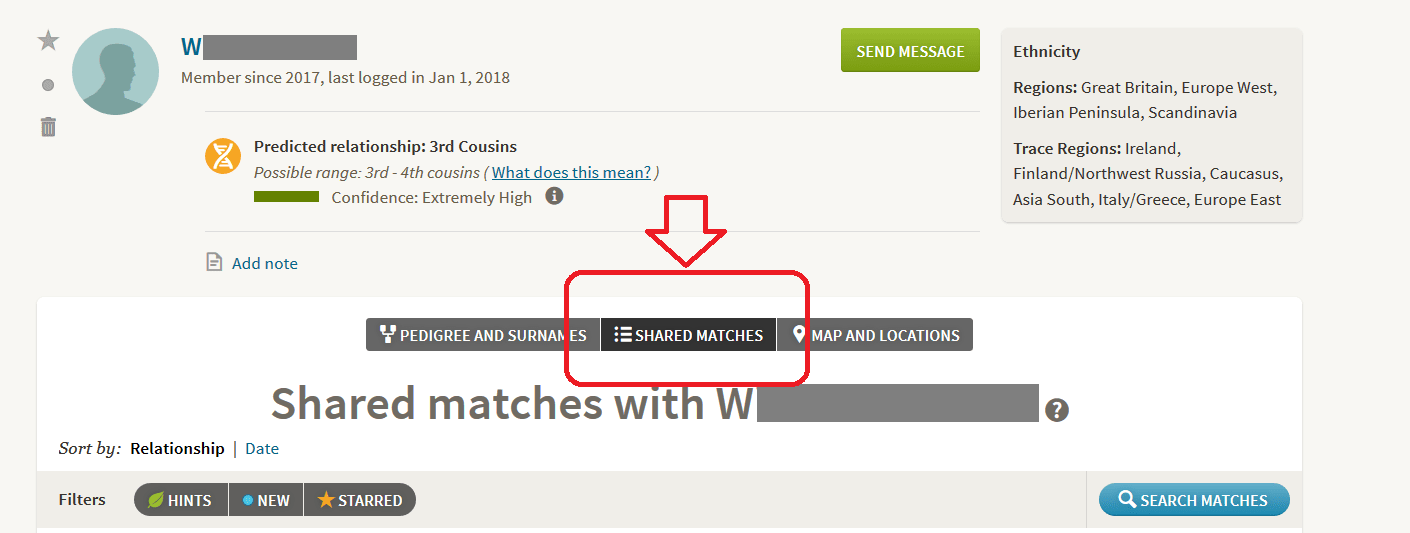
Once you click on Shared Matches, you will see a list of people who share DNA with you and the match you are looking at. This leads me very nicely into the next section...
What is a Shared Match on Ancestry DNA?
A Shared Match is someone that shares DNA with both of you and the match that you are reviewing. Ancestry will only show you shared matches that are 4th cousins or closer, since it is less helpful to show very distant cousin matches as shared matches.
Even so, just because you have a shared match with someone, it doesn't mean that all three of you are related to each other in the same way.
What do I mean by this? Let's say that I have 3rd cousin match on Ancestry. You will likely have several shared matches with a 3rd cousin, since you share a substantial amount of DNA (the more DNA you share, the more shared matches you are likely to have).
So my 3rd cousin match, who we'll call Jennifer, shares several 4th cousin matches with me. Remember, since Jennifer is my full 3rd cousin, we only share 2 out of 16 great-great grandparents with each other.
Another way to think about it is that we will only share 1 out of 8 branches of our family tree at that level.
The fact that we only share 1 out of 8 branches of our tree means that there are 14 other great-great grandparents with completely different lines of ancestors - hundreds of them, if you go back only a few generations. And there is always a chance that some of those 4th cousins that Jennifer and I share in common are related to both of us, but through different lines.
Just as a quick example, Jennifer and I are related to each other through our Dutch great-great grandparents. I have a 4th cousin shared match with her, who is related to me through my 4th great-grandparent who was an English immigrant.
Jennifer is related to this same 4th cousin, but through her German great-great-great grandfather on her mother's side of the family. So we are all related to each other, but not in the same way.
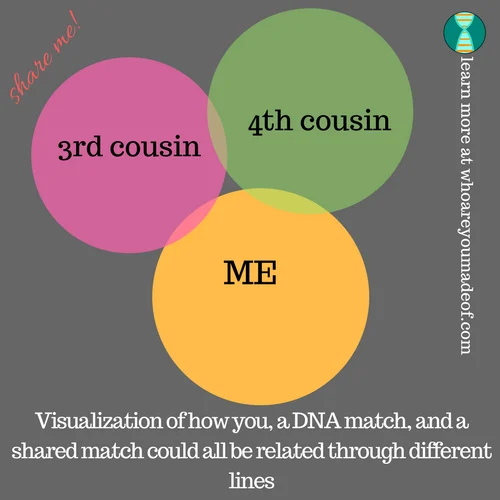
What it means when you share a match with someone
Most often, it means that you, your DNA match, and the shared match, share a common ancestor. Since Ancestry DNA's software won't display cousin matches going back further than estimated 4th-6th cousins, the common ancestor that you all might share could be anywhere from a parent to a great-great-great-great-great grandparent.
The shared matches will be in order of closest to most distant, based on the amount of shared DNA, and organized into basic relationship categories.
In order to figure out exactly how your shared match could possibly be related, check the following items on their profile:
- What is the relationship estimate that Ancestry DNA has assigned? There is a range of shared DNA for every single relationship type, but this can give you a basic idea of how you might be related.
- If the shared match has a family tree that is attached to their DNA, take a peek at it to see if they have any surnames in their pedigree that you recognize
- See how much DNA (in centimorgans) you share with your shared match
- See if your DNA match and the shared match share any ethnicities or common surnames in their tree
Is it possible for a shared match to be related in a different way?
As you know from the previous section, when you share a match with someone, this person may or may not be related to you the same way that the DNA match you are examining is. So what good is a shared match, then, if you can't count on it being helpful in figuring out how your match is related?
There are some "rules of thumb" as far as determining whether or not your shared match has a high likelihood of being related to you on the same line as your DNA match.
Close matches shared in common are likely descended from the same common ancestor
The closer the DNA match, the higher the likelihood that the shared match is related to you on the same line. This is because the closer the relative, the more branches of your tree you have in common (and the less you have not-in-common). For example, if I have a "first cousin" match pop up, I know that we probably share two grandparents. Any matches that we have in common, since we share 50% of our family tree, are very likely to be related to both of us in the same way.
Match and shared matches ethnicity estimates can provide clues
Pay special attention to the ethnicities of your match and your shared matches. Sometimes, if your shared match doesn't share the ethnicity that your DNA match and you both share, you can come to the conclusion that all three of you are related in different ways.
In my own family, since we have a lot of Eastern European, I can often tell which DNA matches are on my mom's Irish side of the family just by checking their ethnicities. Someone who is related 3-4 generations back on my mom's Eastern European side should still show some Eastern European ethnicity.
This isn't a foolproof method, but it is a tool in our toolbox.
Try triangulation to see if your matches are all related on the same line
If you have a lot of shared matches with someone, you might be able to use a crude method of "triangulation" to identify the ancestor that they all have in common, which can give you a clue into how you and your DNA match might be related.
Sometimes, this can reveal some unknown information to us about our own family tree, or help our DNA match learn more about their tree. This can involve a lot of work, but to me it is like a fun mystery - so have a go at it!
How can shared matches help you figure out a DNA match's relationship to you
Shared matches can be extremely helpful, especially if you already know how most of your closest DNA matches are related to you, or if you can get several family members (of different relationship types) to test. I'll tell you a good example of how this exact strategy helped me figure out who my closest cousin match was, and helped her figure out who her biological father is.
When I first did my Ancestry DNA test, my highest match was someone who I was completely unfamiliar with. I only had one other person on my list who was a known relative to me, and they did not share any DNA in common (i.e. they didn't show up as shared matches for each other).
Fairly quickly, I realized that the shared match tool could help me figure out who she was to me. We shared more than 650 centimorgans, so I knew she was someone fairly close.
I knew that she was not on my dad's mom's side of the family, based on the lack of shared DNA with my dad's cousin. A cousin from my dad's other side of the family tested, and there was no shared DNA there, either.
Then, I asked my mother to test - they shared more than 1100 centimorgans! We were getting closer.
A match like this, however, could be still be a few different relationships. My mother's first cousin from her dad's side of the family tested, and there was no shared DNA.
By this time, I knew for sure that it was on my mom's mom's side of the family. Finally, a second cousin on my mom's mom's dad's side of the family did a test, and BINGO.
I knew immediately exactly how she fit into my family tree. I sent her a message, we compared notes, and within 30 minutes, she was talking on the phone with her biological father.
I realize that it's not always very easy to get more people in your family to do a DNA test, and it can also be expensive. The same strategy that I used above can work with a little more elbow grease with 2nd-4th DNA matches and shared matches.
How shared matches can help you break through a brick wall
Sometimes our shared matches are extremely experienced genealogists who have been at this for a while, and we can immediately spot that they have a fantastic, well-researched tree. By comparing our notes, as well as the trees of other shared matches, we can "get a little further back" in our family trees based on what we learn from shared matches.
Other times, shared matches can provide important clues when we are looking for someone mysterious in our family tree. For example, I am researching my great-great grandmother, who was born in Poland.
I don't know much about her. I have a ½ second cousin who is descended from my great-great grandfather's first wife (when she passed, he married my great-great grandmother). When I get new Polish matches, I am able to check to see if he shares DNA with them.
If he does, I know that they are likely not related through my mystery side of the family (not foolproof, but helpful). If he doesn't, I make notes of their ancestors, research their trees a little further back if I can, and then add their names to an Excel file that I keep exactly for the purpose of finding my great-great grandmother's Polish family.
Another situation that happens frequently when I look at shared matches, and then shared matches between that match is I frequently find yet another match that I had previous overlooked, or even bit of information that I didn't even know I was looking for.
Getting more DNA matches can help you solve the "Shared Match" mystery
If you are truly stumped in a branch of your family tree, or are trying to figure out how a particular DNA match is related to you, you might consider uploading your DNA to Family Tree DNA. It's free for the upload, and $19 to unlock all of the features.
This is a great way to see additional DNA matches, which you might recognize as being related to your DNA matches on other sites (including Ancestry). Additional information is always a great way to help figure out these DNA mysteries.
If you want to make the transfer, you can use the link below. I'll get a super small commission at no extra cost to you if you end up making a purchase, and it is so incredibly helpful in helping me support this website.: Click here to transfer your DNA to Family Tree DNA
Conclusion
DNA matches are my favorite aspect of DNA testing, since they really add the human element to family tree research. There is so much that we can learn from each other, and I love to contact newly discovered DNA relatives.
If you have any questions about anything that I mentioned in this post, or would like to add your own personal experience about shared matches, I would encourage you to leave a comment. I love to hear from you!
Thanks for stopping by.


Yvonne Dickson
Tuesday 22nd of August 2023
How do you get your matches to answer your request Mine rarely do, maybe I’m asking the wrong questions thanks Yvonne
A Hydes
Sunday 14th of May 2023
Hi. Thank you for your wonderful posts. I have been ‘hitting’ a brick wall with my Father’s Father for 4 years now. He was born out of Wedlock and no one knows who his father could have been. I have tried almost everything I can think of, to try and figure out this mystery. On my Paternal side I have only 2 close DNA matches. I have their family trees but as I don’t know my grandfather I cannot come up with a connection.
Match 1 - 2nd – 3rd Cousin | Paternal side 4% shared DNA: 285 cM across 10 segments Unweighted shared DNA: 285 cM Longest segment: 86 cM
Match 2 - 2nd – 3rd Cousin 133 cM | 2% shared DNA Paternal side. Shared DNA: 133 cM across 7 segments Unweighted shared DNA: 133 cM Longest segment: 40 cM
Can you give me some advice on where do go from here?
Ethnicity for myself, Match 1 and Match 2 identify Jewish heritage Myself - 22% Match 1 - 25% Match 2 - 99%
Alisa
Thursday 31st of March 2022
How can i be 4th cousins with someone who is not dna matched to any of my 1200 relatives on 23 and me?